The first successful plastic surgery was on Walter Yeo, a wounded soldier from the First World War who lost both eyelids, he underwent one of the world’s first plastic surgeries. Walter Yeo, went under the knife under the supervision of Sir Harold Gillies – the Father of Plastic Surgery Gillies grafted a mask of skin over Walter Yeo’s face and eyes in what was then an innovative new technique. It was only after World War I, surgeon’s skills improved and the field witnessed advancement in technology and in surgical techniques.

Interesting it may seem; here are seven other amazing facts that you probably did not know yet about Plastic Surgery.
- Many people from around the world still live with the misconception that by undergoing plastic surgery, one is injected with a certain amount of plastic into the body and that the whole process is artificial/ fake. However, this is not true. The name “plastic” surgery derives from its Greek roots where “plastikos” means giving shape or molding. In addition to this misconception, other myths that still require a change in attitude is that plastic surgery is only for the vain, the rich and the affluent; that plastic surgery must not be performed until one is 60+ of age; and that the process is toxic and dangerous that may result in many side-effects.
- Another interesting fact originates from the Egyptian rituals, as always, where life after death has much importance. There have been cases where Egyptians have performed surgical alterations or in local terms “plastic surgery” on dead bodies instead of on living ones to make the bodies appear more recognizable in their afterlife.
- Every case of plastic surgery is unique and is different in both preparation and Surgery. Although there might be hundreds of patients lined up for the same nose reshaping technique, all the hundred cases will differ from each other. It is similar to studying the fingerprints of a hundred different people. Hence, plastic surgery is more of an art and not just a saleable product.
- There are several different alternative solutions to the same surgical problem in plastic surgery. The best thing would be to have a discussion with the surgeon and work out a solution that matches your requirements. There are so many different types of Cosmetic Surgery in this field from non-surgical or non-invasive options of fat freezing to tightening of the skin with a facelift.
- As with all surgery, plastic surgery is also accompanied by a stipulated period of recovery time to heal and to see the difference between before and after the operation. Although some people think that the recovery is long, this is not true. While some surgeries may involve just a week to two weeks of recovery time, some other forms of operations might require up to three weeks of recovery time. It does differ from case to case and patient to patient. However, in most cases, recovery time is short and brief.
- Be warned that not all plastic surgeons are to be believed and not all cosmetic medical professionals are plastic surgeons. Plastic surgeons, similar to any other doctor holding a medical degree, need to be board certified to practice plastic surgery on their patients. Believe it or not, a plastic surgeon must spend at least six to seven years at a reputed medical school before taking exams to get certified.
- There are several different types of plastic surgery that have been performed all over the world, some of which include liposuction, Botox, breast augmentation, tissue expansion, reshaping/restructuring, forehead/chin/face-lift, hair transplantation, jaw reduction, and many more. For greater detail, check out plastic surgery options and board-certified surgeons at mymeditravel.com. Among all these different invasive and non-invasive techniques, breast augmentation and reshaping of the nose are two of the most popular performed plastic surgeries around the world, of which more than 90% of the patients are women and the rest men.
